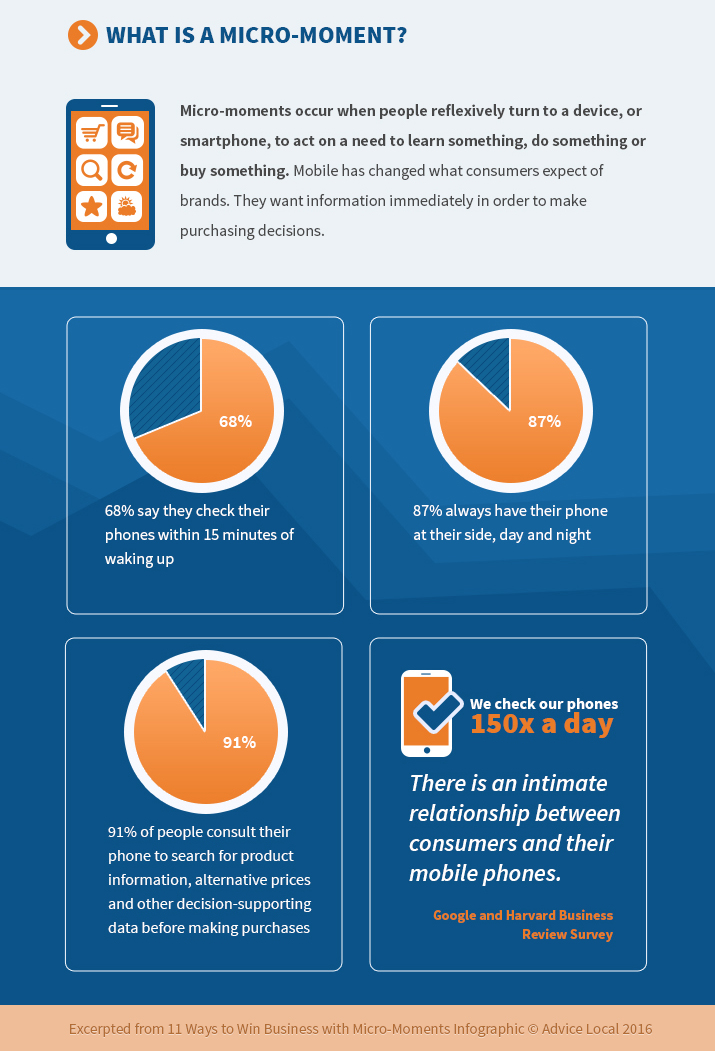Considering how to boost the mobile game? Is your small business (or your client) looking to improve mobile search performance and conversion? You’re in the right place at the right time, as smartphones and tablets are fueling consumer interactions that favor immediate, localized results. Google has dubbed these interactions “micro-moments,” and you can make them work for you.
Micro-moments are snippets of time in which a person wants to learn, find, do, or buy something immediately during their busy day. They grab their smartphone and tap out that need or query into a search engine or app. The micro-moment is that split-second when a person decides to research—and ideally, satisfy—an immediate need.
Consumers are addicted to their mobile devices. The infographic below shares just a few stats showing exactly how dependent consumers are on their phones.

As a consumer yourself, you know micro-moments well: Those times you reached for your phone to check the weather, order carryout on your way home, locate a nearby hardware store or gift shop, or check a bit of trivia to settle a bar bet. And everyone has them—or at least everyone with a smartphone.
Research and Discovery
While it might sound like a mere buzzword, it is so much more, as the micro-moment has fast become an essential entry to the purchase path. Half (51%) of smartphone users told Google they found new products and companies during a mobile search. That means small, local businesses can level the playing field to compete with the big chains.
According to a study from the web measurement firm Hitwise, mobile dominates search for location-based queries, and more than half (56%) of online searches for retailers are made on a smartphone or tablet. What’s more, 82% of “near me” searches originate on mobile; Google says, and half (50%) of the people who perform a local search visit a bricks-and-mortar location within a day.
Mobile searches are conducted on-the-go and even in-store, and such spontaneous activity does not favor the tried-and-true brand, but favors discovery. “We are open to help with decisions we need to make along a journey to accomplish something,” said Matt Lawson, Google’s director of performance marketing. It is very clear that being ready when consumers go fishing for answers pays off.
Local, Voice, and the Micro-Moment
To get ready for mobile, a website must be optimized for mobile. It doesn’t automatically happen without you. Evaluate thoroughly, as roadblocks such as pinch-and-expand can get in the way of consideration and click-through. The mobile site must present the essentials of location, map, hours, a click-to-call option, and deliver it fast. Because mobile has trained consumers to get what they want right away, if they don’t get it they will move on.
Paid advertising can help bring a business to the top of results. Google’s AdWords limits local search results to three on the first page, and reviews can help on apps such as Yelp! But what if site visitors are not purchasing despite great sales at your location? Do you really understand these micro-moments? As Adam Lundquist states: “This change in consumer behavior, on one hand, is a big change, and at the same time it is micro.”
As Google tells us, in the past users were going online, while today now they are living online. People are truly interacting with the world in a different way. Remember when your first reflex for answering a question was to simply ask someone else, consult a map or newspaper, or hit the library? Research reveals that our first impulse today is to consult a handy mobile device to get those answers.
You can further improve SEO and maximize your efforts by determining the questions that potential customers ask in these micro-moments. With speech-to-text inputs, they often sound like questions one might ask a human being. Improvements in voice search and natural language are leading to a dramatic increase in voice queries. When people use voice search they become more natural. Search strings become longer, more conversational. Speak to your clients in website content and the FAQ using a natural tone, and answer the questions they might ask.
Last year, floral delivery network Teleflora launched a new mobile strategy that takes advantage of micro-moments to grow orders. Optimizing its UX, the company was able to head off cart abandonment, then increased paid search at specific times of day to boost mobile revenues more than 50%.
From Intent to Instant Gratification
On an ultralocal basis, let’s observe a couple of friends planning to grab a pizza on a night out. A quick smartphone search for “pizza restaurant near me” yields several results. Clicking through to the top listing they see a logo and pictures, plus multiple buttons offering click-to-call, menu, location and “Like” options, plus a third-party “Order online now” button. Making their choice, within minutes the friends were debating pizza toppings and beverages at their table.
Mobile-wise, that little pizza parlor had it going on! Not only did its site load fast, but it also showed the friends everything they wanted to know with a minimum of clicks. It satisfied an immediate need—sustenance—immediately, and capitalized upon that micro-moment by being top in search, providing relevant information and making the interaction frictionless.
Every micro-moment is rich with intent. Instead of making a potential customer jump through hoops to convert into a lead or buyer, be ready to use these moments to target people at that exact second they decide to take action.
Image Credits
Featured Image: Rawpixel/DepositPhotos.com
In-post Photo: Image by Advice Local





